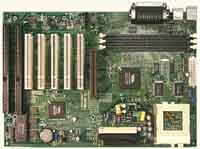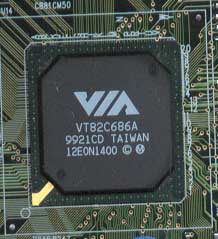Tyan S1598 Trinity MVP3 ATX
by Anand Lal Shimpi on August 18, 1999 10:24 PM EST- Posted in
- Motherboards
For updated information on this motherboard check out our Head to Head comparison that includes this board
Would you ever buy a toaster made by Porsche? It's a funny thought but a very valid question designed to prove a point, just because a company excels at producing a particular type of product, in the case of Porsche it would be high performance sports cars, doesn't mean that they will excel at making any type of product their engineers come up with. Not to boost the ego of the Freemont, CA based motherboard manufacturer too much, but when it comes to server motherboards Tyan has generally produced the "Porsches" of the industry, not only in terms of performance, but in terms of quality and reliability. When Tyan started making more end-user level boards, many users thought they'd be receiving all the quality and attention Tyan's impressive line of server/workstation motherboards were granted, just at a lower cost. Unfortunately, as with any other leader in the industry, Tyan seemed to have a dry spell of poorly manufactured boards dating back to some of the later Socket-7 motherboards they produced.
The company has definitely noticed a comeback in recent times, the quality of their server motherboards have improved, the name Tyan is once again associated with the idea of reliable motherboards and in general, all is well. When Tyan introduced their first Super7 motherboard, the Trinity 100 ATX, the response wasn't that great simply because the board itself wasn't that great of a motherboard. One of the original shortcomings of the K6-2 and K6-III processors is that they haven't been given the opportunity to be paired up with motherboards that are truly deserving of their processing power, a fear that many users have for the future of AMD's latest concoction, the Athlon. Luckily, the adage "better late than never" seems to apply quite well to the Super7 industry as many motherboard manufacturers are going back to the drawing boards to revamp their Super7 designs, present company included. What is the result from Tyan's efforts?
Enter the Tyan Trinity S1598 ATX...
| CPU Interface | Super Socket-7 |
| Chipset | VIA MVP3 |
| L2 Cache | 1MB |
| Form Factor | ATX |
| Bus Speeds | 66 / 75 / 83 / 95 / 100 |
| Clock Multipliers | 1.5x - 5.5x |
| Voltages Supported | 1.3v - 3.5v (0.1v increments) |
| Memory Slots | 3 168pin DIMM Slots |
| Expansion Slots | 0 AMR 1 AGP Slot 5 PCI Slots (5 Full Length) 2 ISA Slots (1 Full Length) |
| BIOS | Award BIOS 4.51PG |
The Good
| The Tyan Trinity S1598 (referred to as the S1598 from now on, no points were deducted from Tyan's score for having an annoyingly long product name) features a layout that has been perfected over and over again over the past two years and has finally become the unspoken standard when it comes to motherboards. The board features the ever-so-popular 5/2/1 expansion slot configuration (PCI/ISA/AGP), with all five PCI slots capable of accepting full length cards and one of the two ISA slots capable of accepting a full length card as well. Provided that you don't make use of the PC speaker connector (J4) nor the ACPI LED connector (J5) on the motherboard the first ISA slot is then capable of accepting a full length card as well. | |
| The board seems quite barren, as do most Super7 motherboards, featuring nine 1000uF electrolytic capacitors surrounding the two switching voltage regulators on the board as well as three 100uF and 2 10uF capacitors. The S1598 has a few places for additional capacitors silk-screened onto the PCB, however for one reason or another the capacitors were hastily pulled from the design. | |
Following the older Super7 motherboard design layouts, the S1598 places the 3 DIMM slots at the upper right hand corner of the motherboard directly below the ATX I/O connectors. Directly below the 3rd DIMM slot lies the 598AT North Bridge, which makes up half of the MVP3 chipset featured on the S1598, the other half obviously coming from the 686A Super South Bridge controller that provides features such as the Ultra ATA 66 support the board boasts. To the right of the North Bridge are the two 512KB 4ns Winbond L2 cache chips and the 8ns 32Kx8 EliteMT Tag RAM module. The board does feature a silk-screened space for a 64Kx8 Tag RAM module, however that option is most likely open for OEM configuration as is the L2 cache size which Tyan offers as 512KB or 2MB in addition to the standard 1MB version. Obtaining a version other than the 1MB S1598, as briefly mentioned, is most likely an option reserved to OEMs alone as the costs associated with releasing three different version of the same motherboard to end users buying one or two boards at most wouldn't be in the best interests of Tyan as a company.
The cacheable memory region of the S1598 is defined by the L2 cache that is present on the board in the form of two 512KB chips, forming a total of a 1MB on-board L2 cache as we just discussed. The actual cacheable memory region of the motherboard is 254MB, meaning that if any memory is accessed above the 254MB limit, it will result in degraded performance during the accessing of the data stored within that memory space. This, of course, does not apply to K6-3 systems, whose on-chip L2 cache takes care of the cacheable memory area of the system.
Surrounded by the Socket-7 CPU interface is a 3/4" thermistor designed to report CPU temperature data to the hardware monitoring integrated into the 686A Super South Bridge controller. Unlike the older Mobile South Bridge (596B), the 686A Super South Bridge boasts a handful of integrated features such as hardware monitoring. Among the other supported features is Ultra ATA 66 support, support for an on-board AMR slot (see Intel 810 Review) and the audio/modem codecs that power it. Unfortunately Tyan chose to take no advantage of the added features of the Super South Bridge outside of the Ultra ATA 66 support, however an Audio I/O connector is silk-screened onto the motherboard potentially for OEM configuration as indicated in the User's Manual. |
|












2 Comments
View All Comments
Anonymous User - Wednesday, July 9, 2003 - link
I am still running this board (tyan s1598 with the 598AT)but do not have an AGP video card in it. I have a K6-3 400 mhz (oc'd at 450, Win98 SE, and 384 MB of ram. What AGP video card(s) would you recommend to get the most performance out of this set up. (7/9/2003)NicholasGuy - Wednesday, July 22, 2020 - link
Thank you for sharing all the standards with us based on which we can make the best selection of the motherboards. As I am going to buy this motherboard soon and I can check https://paperwritingservice.reviews/academized-com... for my help. I hope that this blog and information will help me a lot in this regard.